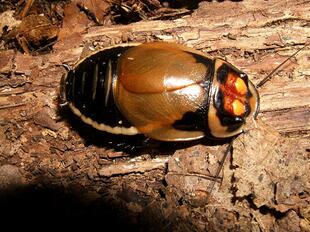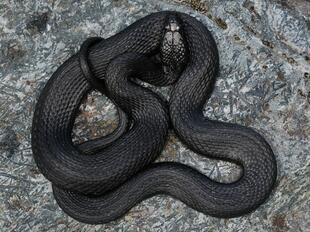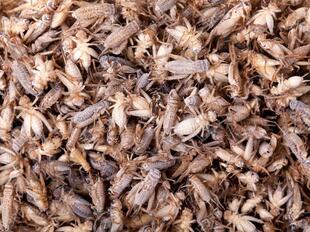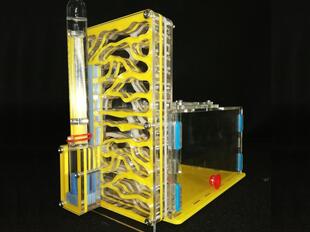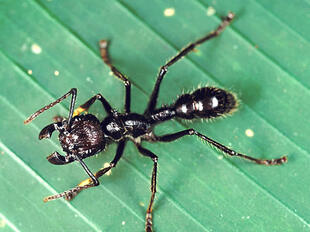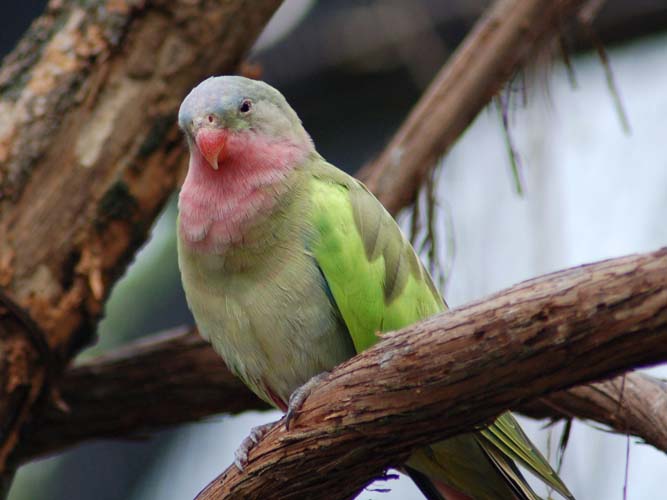
Princess parrot, or Queen Alexandra parrot, or Alexandra's parakeet(Polytelis alexandrae)
Phylum —chordata
Class — aves
Order — psittaciformes
Family — psittaculidae
Genus – polytelis
Appearance
The Princess parrot is a medium-sized parrot, 34 to 46 cm long and weighing between 110 and 120 g. The plumage is mostly green with a pink throat, bluish crown, and bright green shoulders. The rump is blue and the tail is long and narrow. The males have longer tail feathers and brighter coloring than females. The male also has a coral-red beak, while the female's is duller and has a greyish crown. Another difference is that the male has an orange iris, while the female's is much browner. In addition, the male of the species has a longer, projecting extension from the end of the 3rd primary (flight) feather on each side. This projection is called a 'spatula' or 'spatule' and appears in mature male birds.
Habitat
Princess parrot is found only in central and western Australia.
Behavior
This species is nomadic, arriving in small groups to breed and then disappearing. It is one of Australia's least known parrots because it is so elusive, even though it is spread across the interior of Australia. It inhabits arid woodland and scrub with spinifex, eucalypts, acacias, etc. They are unusual among parrots in engaging in mobbing behavior against predators.
Diet
Princess parrots are herbivorous. Their diet is mainly herbaceous plants low to the ground, and grass seeds. Fruit and blossoms of the acacia are their preferred food. They also eat berries and other seeds.
Reproduction
These parakeets are truly opportunistic breeders, with pairs choosing to nest when food is plentiful. They nest in a hollow in a eucalypt or desert oak.
Four to six white eggs are laid which are incubated for 19 days. The chicks leave the nest about 35 days after hatching.
In captivity
Lifespan of these parrotsin captivity – 20-30 years.
A small-medium gauge wire cage with dimensions of at least 35” (W) x 20” (D) x 35” (H) will give your Princess parrot enough room to spread out and exercise without risk of injury from hitting the wire sides.
Open top cages with perching areas are ideal for hand raised birds as they provide more freedom and interaction with their family. At night the cage should be covered with a sheet or cage cover to prevent drafts and reduce visual stress.
Princess parrots are predominantly a seed eating species so their captive diet should consist of a small parrot seed mix, which should contain a variety of seeds such as french white millet, plain canary, hulled oats, pannicum, japanese millet, saff flower and sunflower. Grit assists with digestion so small amounts should be added to their daily seed. Seed lacks important vitamins and minerals so their daily diet should be supplemented with small portions of fresh fruit and vegetables such as apple, carrot, beans, peas, corn, broccoli and spinach. Never feed your Princess parrot lettuce or avocado, and always remove the seeds from apples. Fruit and vegetables should not be left for prolonged periods of time as they will easily spoil and this can lead to illness from the bacteria and yeasts that grow on spoilt produce.
Vitamin supplements such as Soluvite D or Multivet can be added to your Princess parrots’ water two or three times a week. Calcium and Iodine can be provided through cuttlebone and iodine bells. Fresh water should always be available and should be changed on a daily basis. Worming should be repeated every three months with a broad-spectrum bird wormer.
Enrichment is all about enhancing the quality of life for your Princess parrot and generally relates back to activities they would usually perform in the wild. Foraging plays a big part in enrichment for birds. To search for food is a natural instinct all birds possess, so it is the perfect way to exercise both their body and mind. There is a vast range of foraging toys to suit all species of birds and keep them mentally stimulated for when you are not at home. It is a good idea to have several different types of foraging toys available, and to rotate them in the cage every couple of weeks.
Natural branches of varying lengths, shapes and thicknesses should also be provided.
 Russian
Russian
 English
English




















